Wuxi China Art Museum Wuxi China Teapot Shaped Art Museum
H due east's fed upwardly of phallic towers, had plenty of space-historic period blobs and is really rather cross nigh architects handful novelty shapes across his slap-up cities with reckless abandon. China'southward president, Xi Jinping, has called for an terminate to the lightheaded lunacy of weird buildings that have been spawned by the state'southward structure nail over the last decade, crowding out skylines with enormous gold eggs and big pairs of pants.
In a two-hour speech at a literary symposium in Beijing last week, Eleven said that fine art should serve the people, and called for morally-inspiring architecture that should "be like sunshine from the blue sky and the cakewalk in spring that volition inspire minds, warm hearts, cultivate sense of taste and clean up undesirable work styles."
Over the last few years, China's accelerated urban growth, paired with the emergence of a billionaire business course dandy to make its marker, has created a fertile playground for western architects. Lured by the calibration of ambition and sheer speed of building, they have been allowed to indulge in fantasies they could never become away with back home, egged on by cut-price structure costs and safely distanced from the cruel realities of migrant labour weather.
Cities have likewise seen the results of a newly liberated home-grown creative course, allowed to unleash its talents on a scale never seen before. The state-owned architectural institutes have also been infected with a gustatory modality for the iconic and exotic, while provincial business magnates continue to exercise their thing with brassy flair.
Accept a look at some of the strangest species this warp-speed architectural laboratory has produced.
SPACE EGGS
National Centre for the Performing Arts, Beijing
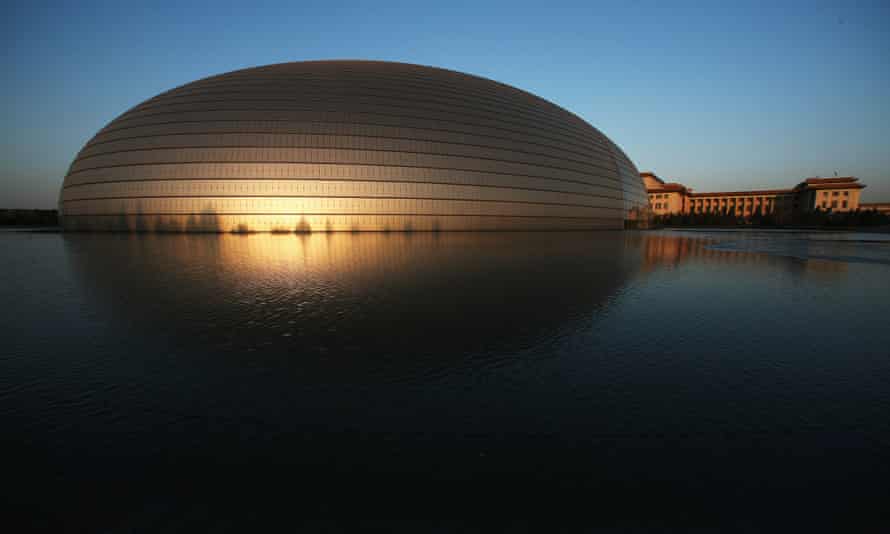
Designed by French architect Paul Andreu, Beijing's opera house was one of the showtime specimens of the infinite-egg genre to arrive in China. It landed next to Tiananmen Foursquare in 2007 like the freshly-laid produce of some gigantic robo-craven, plopped into a lake. An unlikely success story, given that most Chinese insults circumduct around eggs, its ellipsoid titanium dome would go on to inspire a generation of architects with egg-shaped ambitions.
Galaxy Soho, Beijing
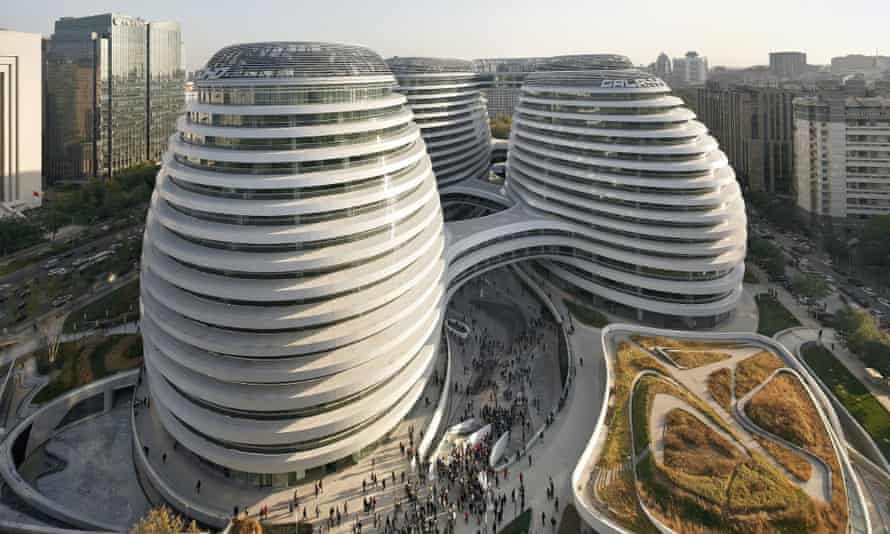
Not to be outdone by a Frenchman, queen of the space egg Zaha Hadid soon laid a clutch of stripy white eggs a petty further east, conjoined past rippling ribbons of architectural albumen forming a swooping world of aerial walkways. It proved so popular with its clients, the Soho grouping, that they deputed another batch of slightly more pointy eggs beyond town – which were then copied past a visitor in Chongqing before the original was even finished.
Henan Fine art Centre, Zhengzhou
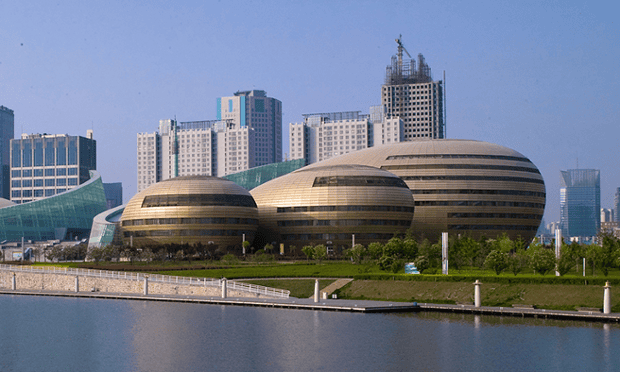
Beijing might at present have a whole basket of space eggs, but Zhengzhou, the capital of nearby Henan province, actually got there first in 2003 and went one meliorate: golden space eggs. Designed by Canadian-based Uruguayan architect, Carlos Ott, the Henan Fine art Centre is apparently not inspired by eggs at all, but intended to resemble abstract versions of ancient Chinese wind instruments – the Xun (a kind of ocarina), the panpipes and the bone-flute.
Phoenix Island, Hainan

Like a cluster of sailing boats undergoing some kind of warp-bulldoze, these globular totems are the piece of work of Communist china's own spawn of Zaha, Ma Yansong of MAD Studio. Part of a luxury bogus archipelago, built off the coast of Hainan Isle in southern China, the evolution was billed as "China'due south Dubai," proclaimed to be a "trigger-happy competitor" for the championship of "eighth wonder of the modernistic world." Simply reports say that it'south speedily turning into a ghost island, as investors rush to offload their apartments following the economic downturn.
Linda Haiyu Plaza, Beijing
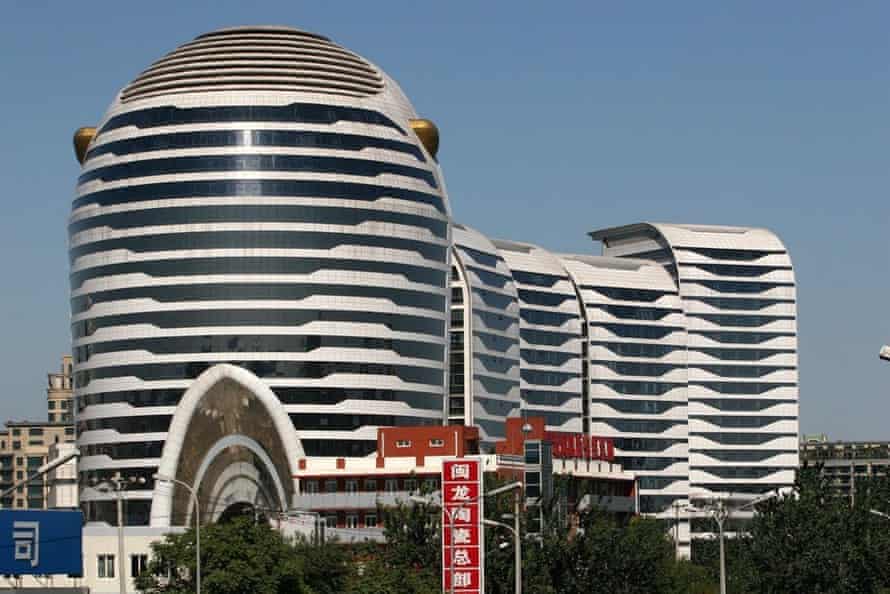
More of a infinite caterpillar than an egg (although its designers claim it resembles a fish), the Linda Haiyu Plaza squats at the corner of Beijing'southward 4th Ring Route, set up to eat you into its gaping oral cavity. It takes the futuristic costume of Zaha Hadid'south Soho projects and stretches it over a series of swollen role towers, like an overweight businessman squeezed into a raunchy spandex leotard.
OBJECTECTURE
Tianzi Hotel, Hebei
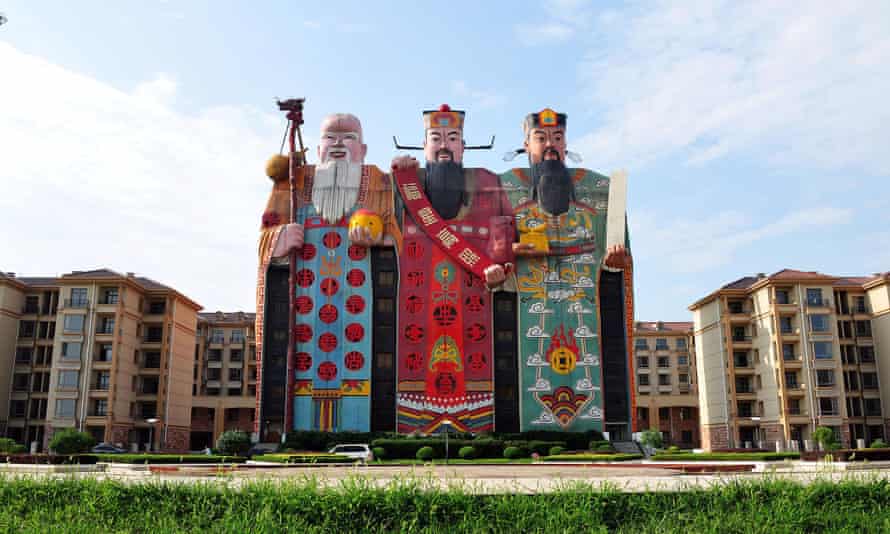
Red china has a fine history of carving enormous buddhas into mountainsides, and one hotel entrepreneur has been keen to proceed up the tradition, erecting a vast trio of habitable gods in the middle of Hebei, e of Beijing. The edifice takes the form of ten-storey high effigies of Fu, Lu and Shou, the Chinese gods of expert fortune, prosperity and longevity. Shou, the beaming chap with the white bristles, welcomes guests through a door in his right pes, while his right hand holds the Peach of Immortality – which houses the hotel's all-time suite.
Wuliangye Yibin building, Sichuan
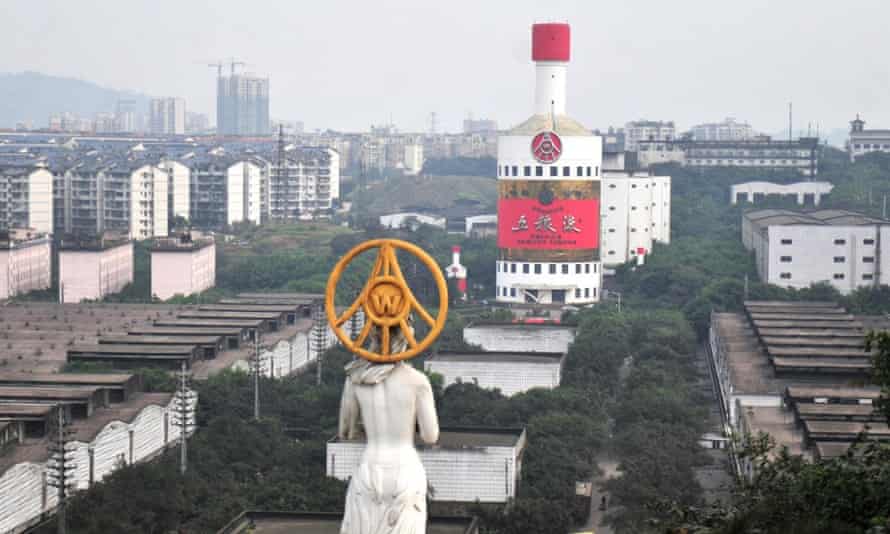
It only seems appropriate that the producer of China'south most potent white spirit, baijiu, has chosen to monumentalise its liquor in the grade of a gigantic bottle building. Indeed, the whole of its factory and company circuitous in Yibin, Sichuan province, is conceived as an alcoholic Alice in Wonderland theme park, with buildings in the shape of the drink packaging and avenues lined with glistening oversized bottles.
Mobile phone edifice, Kunming
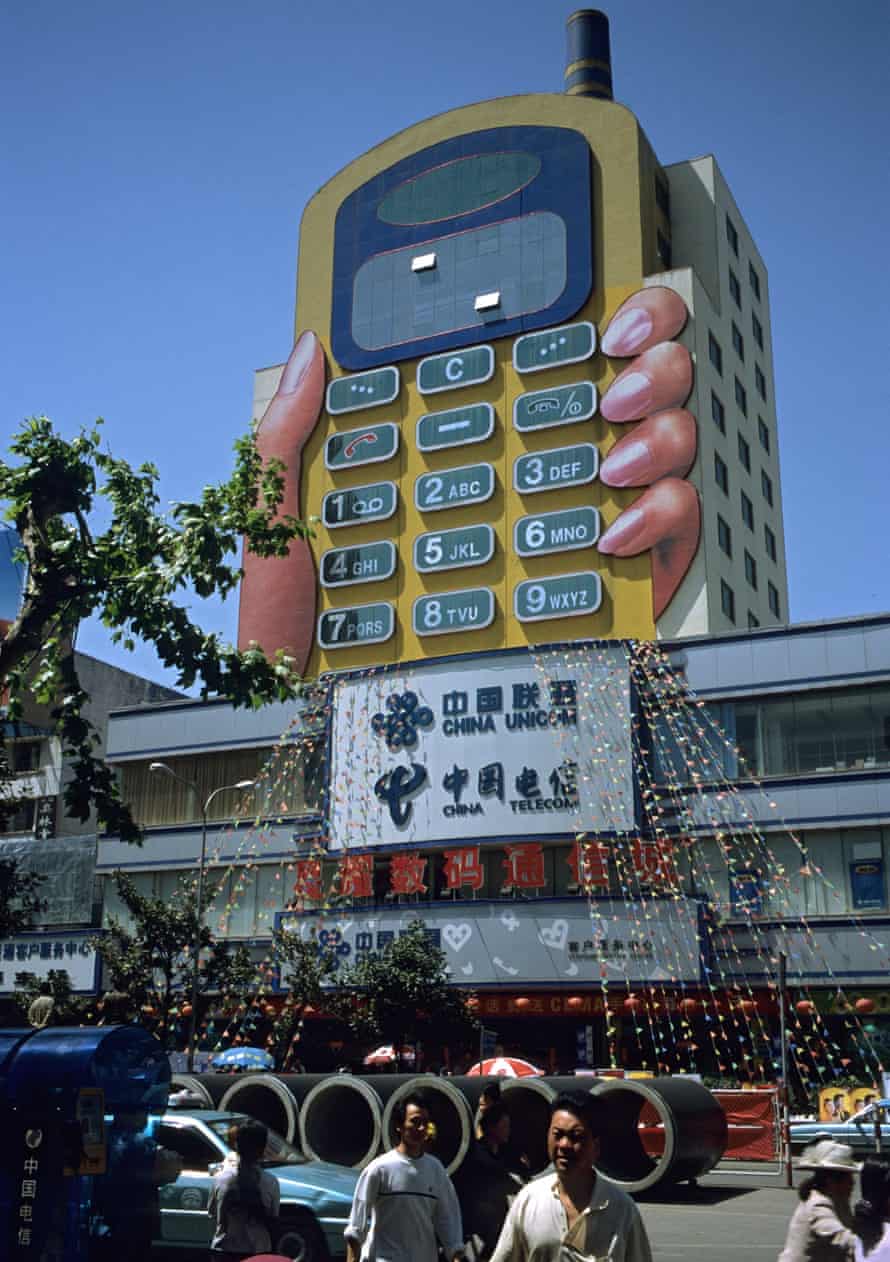
London might have its ain building-sized homage to the phone handset, in the class of the death-ray wielding Walkie-Talkie, but in southern Red china'south Yunnan province they do things much more literally. Rise above Huancheng Road in the provincial capital letter Kunming, the xi-storey mobile phone building features push-shaped windows and a penthouse office floor that looks out through the screen – plus a sinister blue manus, emerging from the footing and clutching its sides.
Piano and violin edifice, Huainan
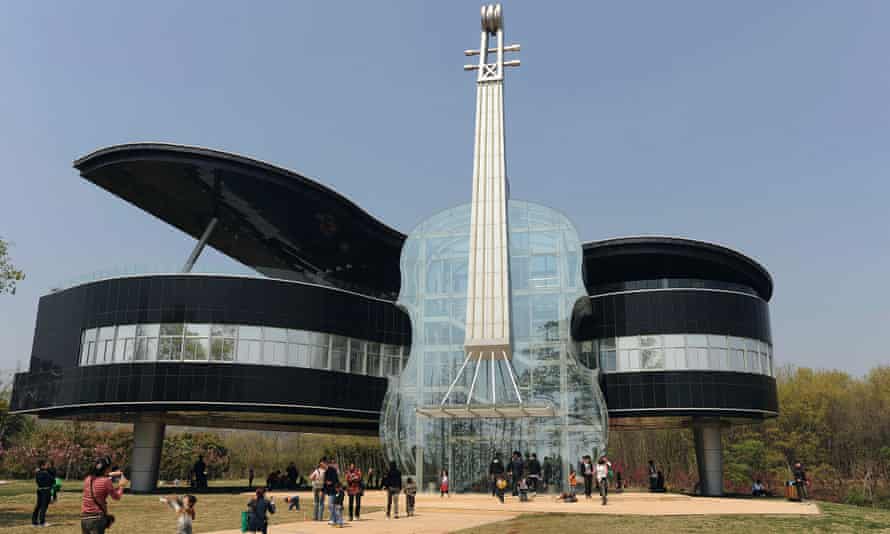
No, it's not Taylor Swift's dream mansion, only an experimental building in Huainan, fundamental Anhui province, designed by a grouping of architecture students at Hefei Academy of Applied science. Conceived every bit a rehearsal and performance space for music students at the local higher, visitors enter through the glass violin atrium, earlier travelling upwards a series of escalators into the bowels of the piano, and on to a roof terrace, shaded past the propped-open lid. Locals have allegedly dubbed information technology "the about Romantic building in China" – though peradventure they don't know that it currently serves as a showroom for the city planners.
Teapot building, Wuxi

What shape does a tourist information centre take in an surface area famous for its red clay teapots? A teapot of form, fabricated all the more spectacular by having been funded by the second richest man in China, Wang Jianlin of the Dalian Wanda group – which is eagerly buying up chunks of London. The 10-storey pot in Wuxi, Jiangsu province, has received the blessings of antique teapot master Wang Jinchuan, who praised the building'south design as "strongly reflecting dirt teapot culture". Who'd take thought it. Only if you lot thought all this was bonkers enough, information technology gets improve: the whole thing can rotate.
Meitan Tea Museum, Guizhou
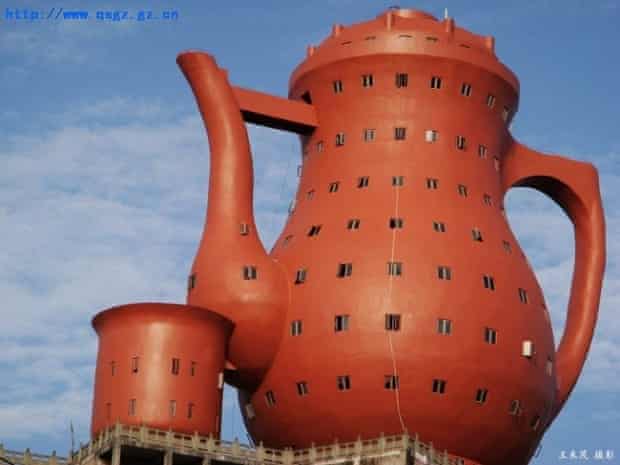
Wuxi's pot may rotate, but it'due south non the biggest teapot building in Prc. That sought-after title goes to the Meitan Tea Museum in southern Guizhou province, which towers 74m every bit a proud symbol of the "hometown of Chinese light-green tea". Coming complete with a neighbouring tea-loving cup building, if it were ever filled it would hold 28m litres of tea. It trounces the previous Guinness World Record for the Largest Teapot Monument (yep, there is such a category), which was ready past the Chester Teapot, built by William "Babe" Devon in West Virginia in 1938 – which stands but four metres high.
Lotus building, Wujin
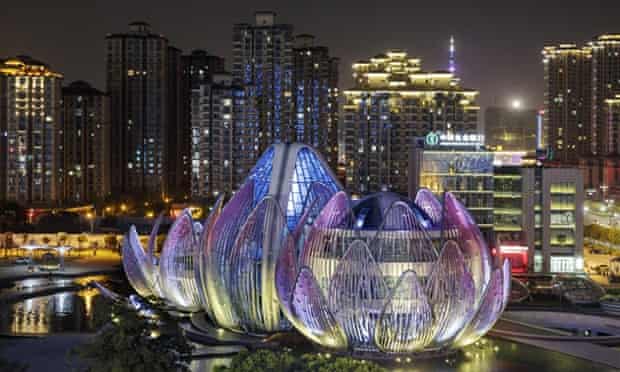
Co-ordinate to its Australian architects, Studio 505, this exhibition and conference center in Wujin, Jiangsu province, was designed as "a giant series of lotus flowers, in varying stages of their life – from the young stiff and tightly wrapped bud, to the vigorous open up flower, through to the mature and fully splayed flower revealing the kernel of new life in the form of the seed pod as the third." The architects themselves describe information technology as "an essay in elegance and restraint". God knows what their other buildings expect like.
Olympic Park, Anhui
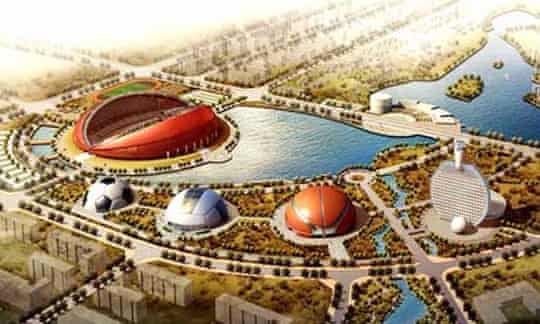
Clearly bidding to become the globe capital of objectecture, already home to the piano and violin building, Huainan City launched an aggressive plan for an Olympic Park in 2011 with venues designed like a load of massive assurance. There would have been a main stadium shaped like an American football game, a swimming pool like a volleyball, two other stadia shaped like a football game and basketball game and, crowning it all, a hotel housed in a 150m tall ping-pong bat – consummate with a panoramic eatery in the handle. Deemed a profligate fancy, it prompted the chiefs of Anhui province to declare a ban on novelty buildings.
GATEWAYS
Ring of Life, Fushun
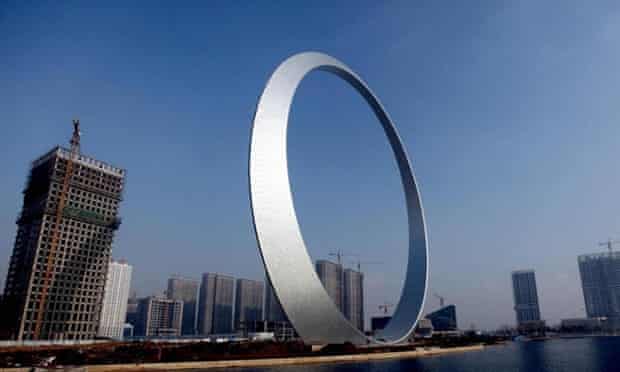
Nothing says 'Wait at our city!' like a massive glowing circle looming above the horizon. Having abased plans for an part edifice and amusement complex (the local population was deemed too pocket-sized to support such a use), Fushun city planners settled on building an enormous empty metal ring to attract tourists to the region. Non to be mistaken for an advertisement for the Dyson bladeless fan, the Ring of Life houses a viewing platform and is fitted with 12,000 LED lights, making it hard to miss by night. Information technology was originally intended to include a bungee-jumping platform at the summit, but the plan was cancelled when the ring was institute to be too loftier to jump from. Some have speculated on other uses for the keen band.
Guangzhou Circle
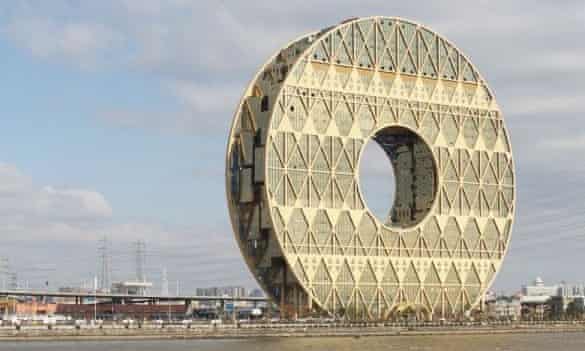
Every bit if a giant cable reel had rolled into boondocks and come to rest on the banks of the Pearl River, Guangzhou Circle towers 138m above southern Red china's largest city like a great copper spool. Housing the earth's largest stock commutation for raw plastic material, information technology is the work of Italian builder Joseph di Pasquale, who says the form was "inspired by the stiff iconic value of jade discs and numerological tradition of feng shui." How so? Because not merely does the 50m-wide hole punched through the centre go far look like an aboriginal Chinese money, but when the edifice is reflected in the river it forms the lucky number eight. And an infinity symbol. And the insignia of aboriginal dynasty that reigned in this area ii,000 years ago.
Sheraton Hotel, Huzhou
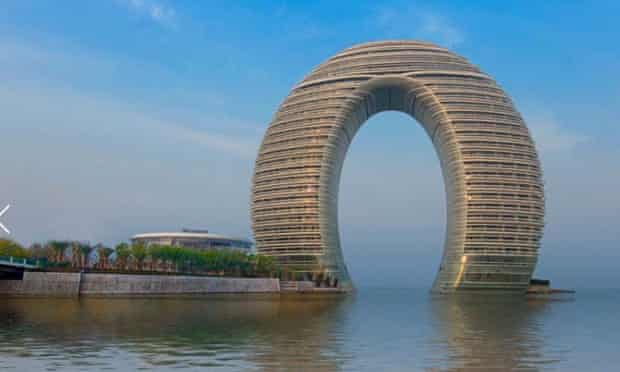
Like a large doughnut dunked halfway into the waters of Huzhou, in Zhejiang province, the Sheraton hotel is another treat from Ma Yansong and MAD Architects. The 27-storey ovoid arch apparently draws on the region's ancient humpback bridges, only souped-upward into a space-historic period glass and steel loop. "Huzhou itself is a place famous for traditional ink paintings and splendid h2o views, and the arch bridge is one of the key elements of traditional architecture," says Ma. But he neglected to mention the inspiration of the splendid traditional outlet of Dunkin' Donuts in the local mall.
Gate of the Orient, Suzhou
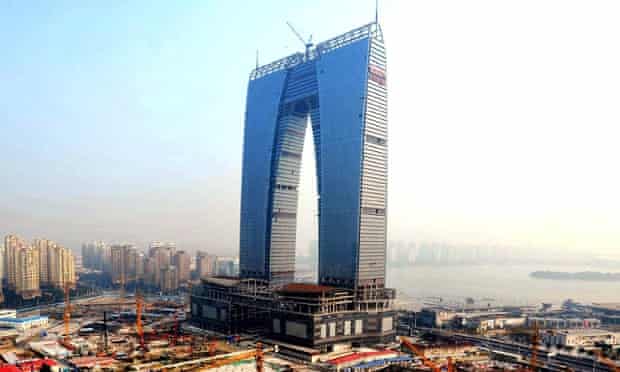
"It'south merely a big pair of pants!" raged local bystanders, as the long legs of the Gate of the Orient were joined together with a royal crotch on the skyline of the ancient urban center of Suzhou in 2012. Soaring 74 storeys into the clouds, the office building has been declared the largest gateway building in the world – and no dubiousness takes the title of the globe'due south largest trouser-shaped building likewise. Designed by British practice RMJM, who should know ameliorate, the building has been declared "humiliating" by some locals, who say walking through its gaping curvation is "like being forced to crawl between someone else'south legs."
CCTV headquarters, Beijing
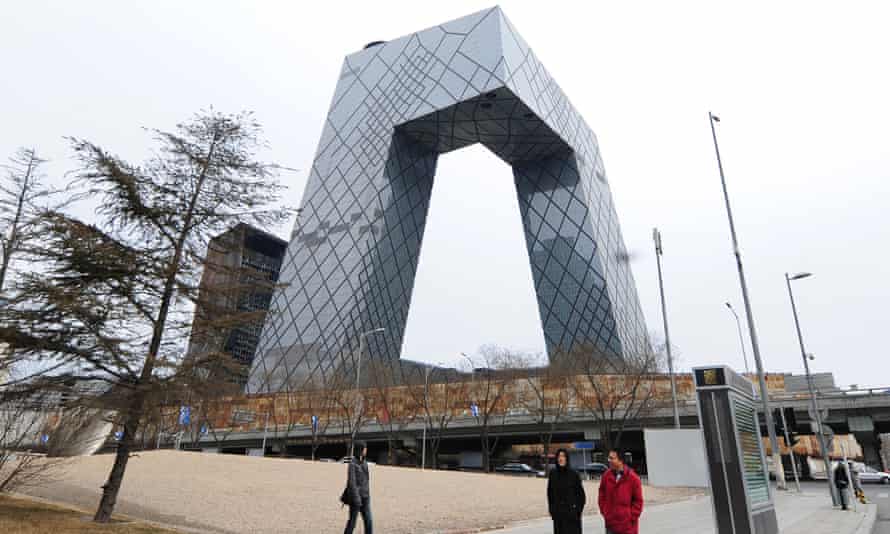
While we're on the topic of undergarments, the headquarters of People's republic of china Central Television, designed by Dutch do OMA, has drawn smutty sniggers and been nicknamed the "large boxer shorts" – as well as likened to someone squatting above the city, ready to offload a nasty surprise. It is a menacing gateway, modelled on New York's twin towers bent double and knotted in a abrupt cantilever, and an appropriately sinister symbol of the state-controlled propagandist mouthpiece. But the grade has also proved something of a hit, and has already been copied in other cities in Red china.
Source: https://www.theguardian.com/artanddesign/architecture-design-blog/2014/oct/23/-sp-chinas-strangest-buildings-from-pairs-of-pants-to-ping-pong-bats
0 Response to "Wuxi China Art Museum Wuxi China Teapot Shaped Art Museum"
Post a Comment